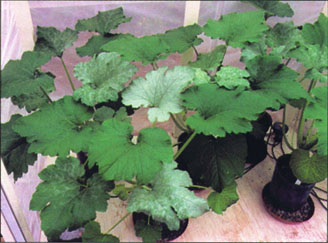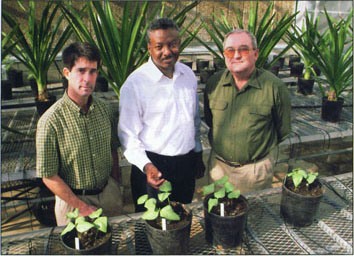All Issues
Sidebar: News from the UC plant genomics frontier
Publication Information
California Agriculture 54(4):11-12.
Published July 01, 2000
PDF | Citation | Permissions
Full text
Since recombinant DNA technologies were first developed in the 1970s, scientists have made dramatic advances in understanding how plants germinate, grow, reproduce and interact with the environment. Much basic research in plant molecular biology has focused on the mechanisms of gene expression — how particular genes are turned on or off — and on identifying and cloning genes that bestow specific traits such as disease or pest resistance. Recently, scientists also have made great strides in sequencing plant genomes. Following are some recent breakthroughs by UC researchers.
Disease resistance.
UC Davis plant pathologist Pam Ronald has been a pioneer in determining the genetic basis of bacterial blight disease resistance in rice. In 1995, using plants native to West Africa and bred into cultivated varieties at the International Rice Research Institute, her team isolated the Xa21 gene, the first cloned gene known to confer disease resistance in rice. By cloning and transferring the gene into other rice plants, the researchers made it possible to create novel resistant varieties.
More recently, as reported in Science (June 30, 2000), Ronald and colleagues at the Salk Institute for Biological Studies discovered that the Xa21 receptor domain that recognizes the bacterial blight pathogen and signals the plant's defense response can be swapped with another receptor domain. The new protein now recognizes another molecule. Scientists may be able to engineer resistance to other pathogens by altering the receptor domain to recognize them.
Silverleaf whitefly.
UC researchers are elucidating how plants respond to pests as well as pathogens. UC Riverside plant geneticist Linda Walling and collaborators Mien van de Ven, Cynthia LeVesque and Tom Perring have revealed how plants respond to the silverleaf whitefly. This insect is a devastating crop pest that vectors an array of debilitating viruses and causes dramatic developmental disorders, such as squash leaf/fruit silvering and tomato irregular ripening, that impact the market value of fruit. As reported in The Plant Cell (August 2000), the investigators compared plant responses to the silverleaf whitefly and the closely related sweetpotato whitefly. They have identified plant genes that are preferentially expressed in response to the silverleaf whitefly, but not the sweetpotato whitefly. The species-specific signals are transported from silverleaf whitefly-infested leaves to upper noninfested leaves to activate plant gene expression. Studies with the silverleaf whitefly-induced gene SLW3 indicated that known defense and wound signals do not activate this gene. It appears that the silverleaf whitefly's saliva may contain a novel elicitor for the systemic activation of SLW3 or that the silverleaf whitefly stimulates the squash plant to generate this novel systemic signal. These findings might lead to production of plants that would not silver when infested with the silverleaf whitefly or might exhibit enhanced defenses to phoem-feeding insects.
Cold-tolerant crops.
Also at UC Riverside, geneticist Timothy Close and colleagues Abdelbagi Ismail and Anthony Hall are making discoveries that could lead to more chilling-tolerant crops. In the Proceedings of the National Academy of Sciences (Nov. 9, 1999), they reported the identification of a gene in blackeye beans (a type of cowpea) that enables seeds to germinate and plants to emerge in cool soil.
Warm-season plants sown early in the growing season often fail if the soil is too cool. During an unusually cool spring in 1995, the researchers observed a link between a type of stress protein called a dehydrin and genetic variation in chilling tolerance in cowpea plants. One cowpea breeding line emerged more successfully than a closely related line. The successful line contained a large quantity of a specific dehydrin, which could not be detected in seeds of the other lines.
By studying squash plants infested with silverleaf whitefly, below, and plants infested with the closaly related sweetpotato whitefly, which does not cause silvering, UC Riverside scientists are learning more about genes involved in crop damage.
The researchers identified the gene that encodes for expression of the dehydrin protein and found there is indeed a genetic link between the gene and the trait. This knowledge gives scientists a new approach for improving cowpeas and perhaps other warm-season crops such as soybean, cotton, corn, rice and sorghum.
Timothy Close, UCR geneticist, left, and UCR plant physiologists and breeders Abdelbagi Ismail and Anthony Hall are working on a way to grow warm weather plants in cool soil.
Light responsiveness. UC Berkeley molecular geneticist Peter Quail studies how plants sense and respond to light stimuli. In recent years his team has identified and cloned five molecules called phytochromes, plants' primary photoreceptors, and is elucidating how they convert light stimuli into molecular signals that switch on target genes. In Science (May 5, 2000), the researchers reported that when phytochromes are activated by light, they accumulate in a cell's nucleus and bind to promoters of light-activated target genes, thereby regulating their expression. In this way the phytochromes act as light-activated molecular “switches,” modifying gene expression. The scientists also identified a transcription factor, PIF3, that plays a key role in this process. When activated by sunlight, phytochrome B binds to the PIF3 protein; this binding does not occur if the plant is kept in the dark.
The work has major implications not only for basic science but for the potential to produce transgenic plants with altered responses to light. For example, plants might be engineered to germinate or flower at particular times controlled by growers.
Plant Gene Expression Center. Quail is affiliated with the Plant Gene Expression Center (PGEC) in Albany, one of the world's leading research institutions in plant molecular biology. Established in 1984, the center represents a unique arrangement between the USDA Agricultural Research Service and UC. The USDA scientists at the center have adjunct appointments with the UC Berkeley department of plant and microbial biology, where they can teach and train students.
As a UC Berkeley collaborative researcher at PGEC in the early 1990s, Peggy Lemaux, one of the first two Cooperative Extension specialists in biotechnology in the United States, led the team that developed the world's first transgenic barley. Other center achievements have included cloning tobacco's N gene, a key element in viral resistance, and the ACC synthase gene, which can be manipulated to control fruit ripening.
Arabidopsis genome. In addition to probing particular genes, UC plant scientists are leading major attempts to map the complete genomes of a variety of plant species. Genome sequencing and global gene expression analyses take plant genetics research to a whole new level — that of the entire organism — in the subfield of plant biotechnology known as genomics. PGEC's Athanasios Theologis is collaborating with researchers at Stanford University and the University of Pennsylvania in a landmark effort to sequence the Arabidopsis genome, which will allow plant scientists worldwide to identify homologous genes from important crops such as tomato and soybean. The researchers anticipate major breakthroughs in this work before the end of this year.
Wheat genome.
UC is a leading participant in the U.S. Wheat Genome Project, a $7.3 million, 4-year project funded by the National Science Foundation with the goal of deciphering the chromosomal location and biological function of all genes in the wheat genome. The project, the first such effort for wheat, began in September 1999. Calvin Qualset, director of the UC Genetic Resources Conservation Program, leads the project with 13 co-principal investigators from across the nation, three of them with UC: Davis researchers Jan Dvorak and Jorge Dubcovsky and Riverside's Close.
Research in plant genetics requires multi-investigator, multi-institution collaborations, primarily due to the high equipment costs and efficiency of shared bioinformatics strategies and data analysis. A proposed institute could become the focal point for this work throughout the UC system.
In July, the state legislature approved funding for three California Institutes for Science and Innovation to be based at UC. This fall an international panel of scientists and scholars will select three institutes from six proposed, one of which is the California Institute in Agricultural Genomics. The UC Riverside campus would lead this institute, working in partnership with the Berkeley and Davis campuses.






